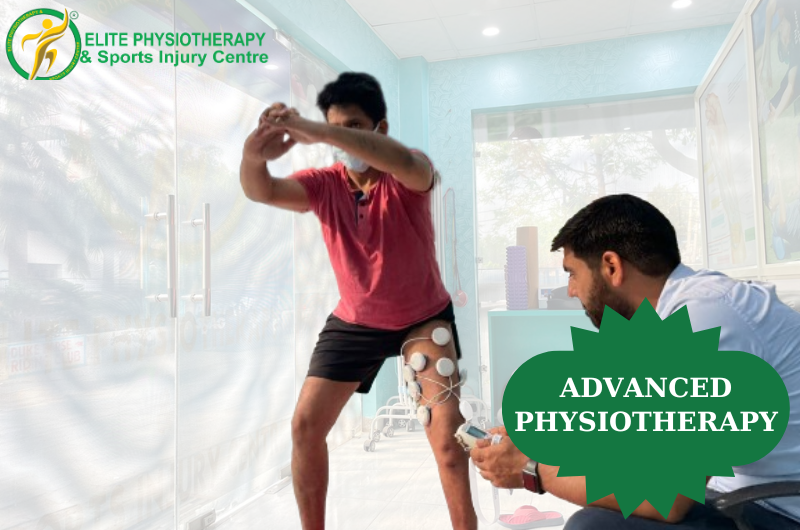
Advanced Physiotherapy
Advanced physiotherapy encompasses cutting-edge techniques and technologies designed to enhance patient recovery and rehabilitation. This holistic approach integrates traditional physiotherapeutic methods with innovative interventions such as virtual reality, robotics, and tele-rehabilitation, tailoring treatments to individual needs. By employing evidence-based practices, advanced physiotherapy aims to optimize physical function, manage pain, and improve overall well-being across diverse populations, including athletes, the elderly, and those with chronic conditions or post-surgical recovery needs. Emphasizing patient education and self-management, it fosters independence and promotes long-term health benefits, embodying a forward-thinking perspective on rehabilitation and physiotherapy.
Questions
WHAT IS ADVANCED PHYSIOTHERAPY?
Modern methods and top-notch equipment are necessary for a clinic that offers physiotherapy services. Superior Advanced physiotherapy tools and methods provide excellent care and quick healing. Modern, high-tech equipment is revolutionizing physiotherapy to a whole new degree. These tools and methods are being created for therapy, which yields far superior outcomes than conventional therapy.
HOW DOES ADVANCED PHYSIOTHERAPY DIFFER FROM TRADITIONAL PHYSIOTHERAPY TECHNIQUES?
A variety of specialized methods and strategies are referred to as advanced physiotherapy, and they are used to assist control pain, increase range of motion, and encourage recovery. These methods frequently entail the use of specialized instruments and equipment in addition to manual manipulation of the body's soft tissues. In contrast to regular physiotherapy, advanced physiotherapy may be utilized for more complicated or long-term illnesses and usually requires more specific training and experience.
WHAT ARE THE DIFFERENT TYPES OF ADVANCED PHYSIOTHERAPIES?
To reduce pain, increase mobility, and encourage recovery, sophisticated physiotherapy treatments can be applied. Here are a few of the most popular methods along with a succinct description of how they function:
Shockwave therapy: To treat a range of musculoskeletal disorders, such as plantar fasciitis, tennis elbow, and shoulder discomfort, this method uses high-frequency sound waves. In addition to promoting tissue regeneration and lowering pain and inflammation, sound waves also aid to increase blood flow.
High Intensity Class 4 Laser therapy: lasers are used in laser treatment to treat a range of ailments, such as soft tissue injuries, back discomfort, and arthritis. By stimulating the cells in the damaged area, the lasers aid in tissue healing and reduce inflammation.
Spinal decompression therapy: A unique tool is used in spinal decompression therapy to gently extend the spine and release pressure from the discs and nerves. It is frequently used to treat sciatica, herniated discs, and other back pain-causing disorders.
Neuromuscular electrical stimulation (NMES): This technique stimulates muscles and nerves with electrical impulses, increasing muscle strength and decreasing pain and inflammation. It is frequently used to treat ailments such spinal cord injury, multiple sclerosis, and stroke.
Manual therapy: Manual therapy is a hands-on approach of manipulating soft tissues, including ligaments, tendons, and muscles. It can involve joint mobilization, massage, and stretching, and is frequently used to lessen discomfort and increase range of motion.
Dry needling: This method releases tension and lessens discomfort by inserting tiny needles into trigger points or tense muscles. Though it is based on Western anatomy and physiology, it is comparable to acupuncture.
Cupping therapy: This modality includes applying suction cups to the skin in order to increase blood flow and lessen inflammation and discomfort. It frequently works in tandem with additional manual treatment methods.
Kinesio taping: This method supports muscles and joints and aids in healing by applying a specific kind of elastic tape to the skin. It is frequently applied to enhance athletic performance and treat sports injuries.
Hydrotherapy: This method uses hot and cold water therapy, swimming, or aquatic exercise as well as other water-based therapies to improve healing and lessen inflammation and discomfort.
HOW CAN A PHYSIOTHERAPIST DETERMINE WHICH ADVANCED TECHNIQUE IS APPROPRIATE FOR A PARTICULAR INDIVIDUAL OR CONDITION?
A comprehensive evaluation of the patient's condition, including their medical history, symptoms, and any prior therapies or treatments, is usually the first step taken by a physiotherapist. They can then create a customized treatment plan based on this information, which can involve other complementary treatments or interventions in addition to one or more advanced physiotherapy approaches.
Advanced techniques can be recommended to someone who has a painful long-term condition and has not responded well to previous treatments. These techniques support the healing process, improve the condition by supporting the affected structures, and enhance the patient's quality of life.
WHAT ARE THE BENEFITS OF ADVANCED PHYSIOTHERAPY?
Depending on the particular ailment being treated, sophisticated physiotherapy treatments might have different effects. Nonetheless, a few possible advantages can be:
- Reduced pain and swelling
- Improved range of motion and mobility
- Enhanced power and endurance
- Quicker recovery and healing
- Decreased possibility of complications or injuries
WHICH CONDITIONS ARE TREATED BY ADVANCED PHYSIOTHERAPY?
Treatment options for a variety of musculoskeletal, neurological, and cardiovascular disorders include advanced physiotherapy methods. The following are some of the most typical ailments that can be managed with cutting-edge physiotherapy:
Chronic pain: Conditions such as fibromyalgia, neck pain, and low back pain can be treated using advanced physiotherapy techniques.
Sports injuries: Sprains, strains, and rips are among the ailments that may be managed and healed using advanced physiotherapy techniques.
Post-surgical rehabilitation: Following surgery, such as joint replacements, ACL repairs, and rotator cuff repairs, advanced physiotherapy techniques can be employed to improve healing and restore function.
Neurological disorders: Parkinson's disease, multiple sclerosis, stroke, and other neurological illnesses may all be treated using advanced physiotherapy techniques.
Cardiovascular problems: Heart disease, hypertension, and pulmonary illnesses are only a few of the conditions that may be treated using advanced physiotherapy techniques.
Arthritis: Osteoarthritis, rheumatoid arthritis, and psoriatic arthritis are among the conditions for which advanced physiotherapy techniques can be utilized to reduce pain and inflammation.
Women's health issues: Pelvic floor dysfunction, urine incontinence, and pregnancy-related discomfort are just a few of the disorders that may be treated using advanced physiotherapy techniques.
Geriatric conditions: Osteoporosis, balance issues, and falls are just a few of the ailments that may be treated using advanced physiotherapy techniques.
